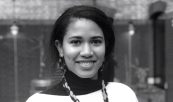
Juni 2017
Future of Work: Creating a Culture That Nurtures Diversity in Teams
We need a culture of dialogue. - Rahel Aschwanden, NOW
It’s fairly well accepted by now that diversity is good for the workplace and its outcomes. On an individual level, it’s good for diligence, it’s good for creativity and it’s good for innovation.
For organizations, diversity is recognized as being good for returns on equity, although not necessarily in a directly causal way. It has, however, been observed that when companies commit themselves to diverse leadership, they are more successful. And—a perhaps less recognized factor—organizations that embrace inclusivity (which is the action-focused part of the diversity discussion) are more attractive to employees, especially when they know their company is committing time and money to inclusivity.
But here’s the rub: We talk about inclusion in order to activate our attempts to support diversity but, as scholar Dr. Dafina-Lazarus Stewart has commented, if we’re looking for transformational change within our organizations, diversity on its own—without an equity and social justice intent—lacks a ‘rudder’.
This insight may partly explain why, in looking at various socially diverse groups, a 2014 Scientific American article cited the existence of: “discomfort, rougher interactions, a lack of trust, greater perceived interpersonal conflict, lower communication, less cohesion, more concern about disrespect, and other problems.” Because when there’s no common intent that’s tied to deeply held values (such as equity and social justice), a group is less able to find their way.
It’s a bit like Dr. Brené Brown’s observation that a story is ‘data with a soul’: diverse teams that take the time to work on their ‘soul’ are better able to strengthen their ‘data’, thus creating a powerful, shared story. And what is a purposeful story, after all, if not a powerful instigator of change?
So how do we ground diversity in order to achieve lasting change?
It’s one thing to say, ‘Yeah, diversity and inclusion sounds like the PC thing to do!’ but it’s another thing altogether to know what to do with that.
It’s therefore, as first step, worth putting the ‘Diversity’ discussion on the agenda for the next meeting, either for building a team, or for re-shaping an existing culture.
I recently spoke with Rahel Aschwanden of the NOW organization (which holds diversity as key to their mission for social change), and she had some insights that I’ve treated as a springboard or starting point for these action ideas.
And, in keeping with the material, I’d invite you to take the time to read and to think about it, and especially to discuss it.
There are no quick answers; there is no check-list or road-map. (I had to fight the urge myself.) It’s simply a collation of ideas that may kick-start dialogues. Because, at least in the case of embracing diversity and inclusion, every team and every individual is unique. So dialogue is critical.
Idea 1. Building awareness and reframing difference
Diversity isn’t just one person; it’s all of us. - Rahel Aschwanden
An exercise in learning about our team
‘What is ‘difference’ to you?’ is a question we can ask ourselves and our teams and communities. In doing so, we may discover that the Muslim in our group sees their dyslexia (rather than their hijab) as their biggest personal challenge for inclusion in the team. We may discover that our team’s challenges aren’t just about gender or religion or nationality, or the obvious colour of skin, but might be age, socio-economic background, sexual orientation, or even a preference for silence in the workspace. It’s about the lenses we can learn to apply (or discard), and becoming aware of our assumptions. We can also gather information about whose voices may not be represented, or who may be being overlooked within in our team.
An exercise in reframing difference
Draw an iceberg with its tip above the water. Make sure 90% of the iceberg is below the water.
In the region ABOVE the water (10%), write down any ideas you have for the things we can learn about others by using our senses (sight, touch etc.). This is the stuff most often in our realm of conscious thought.
Now brainstorm everything BELOW the waterline: all the stuff that is hidden from our senses, and is therefore deemed unconscious thought.
The idea is that even if we are with a group of people who are visibly similar, for example, there’s actually likely to be quite a wide range of diversity within that group, depending on which lens you choose to view them with.
Check out this Danish TV advertisement for more on reframing difference:
Idea 2. Be prepared to invest (or change the way you think about time!)
In business, time is money, but in order to creative diversity and inclusion and beyond, we must invest … Building diverse teams takes patience. A lot of patience. - Rahel Aschwanden
The experience of ‘spending’ time without immediately apparent (i.e. spreadsheet-able!) ‘outcomes’ can be frustrating for some people (as we discovered last time, when we were investigating holacracy.
But the very concept of time as an ‘investment’ is intrinsically linked to linear ways of looking at productivity, and the ‘exchange mentality’ that some could argue has been embraced and nurtured since we started mapping economics using the laws of physics. So, in that sense, for some organizations or teams, it can be useful to think about developing language that enables us to talk about how we’re spending time, because if the goal is to have a diverse team that functions well as a team, check-box/data-focused language might not be moving us forwards.
Idea 3. Values matter
Being clear on our values is critical. - Rahel Aschwanden
The challenge for those of us working with a diverse group of people is to find ways to connect, to make the specifics of our very different strengths and skills and experiences relevant or known to somebody else, by tapping into the themes that are shared.
One way to do this is to bring the ‘values’ discussion to the table. For some groups, this discussion may take much longer than for others, as people will have different cultural approaches and expectations when it comes to sharing personal views and core values. However, it is worth persisting, because once we are aware of shared values we can start to develop a shared language, and we are more able to see each other (and our team) as ‘all in the same boat’.
As Aschwanden has said, “Our personal stories are often the path to connection.”
Idea 4. Actively foster open dialogue
Open dialogue is key to having a culture of diversity and inclusion, and a broader discussion beyond ‘the one woman on the executive board’, for example. - Rahel Aschwanden
To that end, it pays to actively create opportunities (such as lunchtime talks) for educating ourselves about areas of difference.
We have discussed some of the more obvious areas of difference (such as skin colour, gender, nationality, sexual orientation, age, or socioeconomic difference) but there are many opportunities to investigate less obvious areas of difference, such as: types of intelligence or ways of thinking (analytic and abstract), personality types (such as the introversion/extraversion scale), or learning styles (visual, auditory, kinesthetic, etc.).
Key to successful dialogue around new topics is to engage in high-trust behaviours that are appropriate to our team’s culture: for example, demonstrating respect, modelling clean communication, active, deep listening, and keeping commitments, in order to create a comfortable space in which to explore new and unfamiliar topics.
Idea 5. Embrace learning and responsibility for our own mindset
The social justice approach would be that it’s not the ‘minority’ person’s responsibility to educate people; they can only speak for themselves, as can we all. - Rahel Aschwanden
Humans are born to grow, and being faced with challenges like working with someone who is visibly or behaviourally ‘different’ than us gives us many opportunities to do just this. We can educate ourselves, and we can do the work to investigate our beliefs and our attitudes towards others.
Communication is an especially ripe area for growth, as it is our interface with others. A lot can be gained from learning listening skills, and practicing mindfulness to become more present when we are in conversation with others.
We can certainly invest in educating ourselves about different communication styles (direct and indirect communication, for example) in order to be able to let go of our expectations and our attachment to outcomes. And we can investigate ways to manage conflict (how to move away from hostility towards productive conflict, and conflict resolution).
With thanks to Rahel Aschwanden for insights.
And don’t forget to sign up for our Impact Hub newsletter if you haven’t already…to get the newest blog posts directly into your mailbox and find out about events and goings-on.
Newsletter abonnieren
Unser Newsletter erscheint alle 3-4 Wochen und stellt sicher, dass ihr nichts aus der Community verpasst.



